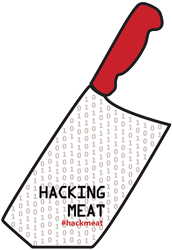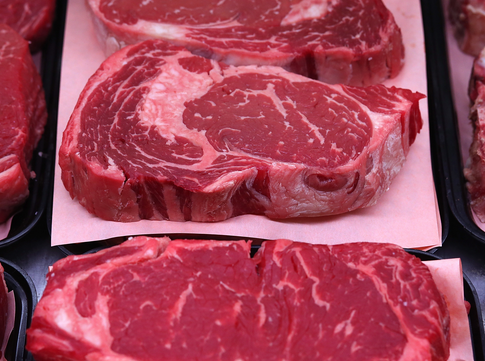
Food+Tech Connect and GRACE Communications Foundation present Hacking Meat, an online conversation exploring how information and technology can be used to hack (or reimagine) a more sustainable, profitable and healthy future for meat. Join the conversation and share your ideas or product requests in the comments, on Twitter using #hackmeat, Facebook , Tumblr or at the Hack//MeatSilicon Valley happening June 21-23 in Palo Alto.
Guest Post by Jonathan Kaplan, Natural Resources Defense Council (NRDC)
The meat aisle of most grocery stores is a troubling place. I see the same pattern every time I go: rows and rows of neatly shrink-wrapped meat, carefully labeled, dated and priced. And completely anonymous. This meat bears little indication of the supply chain that enabled its arrival: Aasupply chain that we food advocates know often degrades communities, endangers workers, pollutes air and water and air, proliferates drug resistant bacteria, torments animals and threatens the livelihoods of farmers.
But then, increasingly, in some remote corner of a freezer or refrigerated shelf, sit a handful of organic or sustainably certified products — often at a price point that stands out like a sore thumb. I can’t prove it, but I believe that many sustainable meat alternative products are marketed to a narrow group of consumers at a significant price mark-up that is quite a bit higher than the producer’s actual additional costs. So consumers mostly get to choose between anonymous competes-on-cost-only meat and a significantly more expensive niche product.
Where’s the middle? A few companies like Applegate, Panera Bread and Chipotle are offering antibiotic-free meats for a cost-competitive, mainstream market. This is very exciting stuff. But by and large, the marketplace seems to think that only a few of us are interested in a higher value, sustainable product.
NRDC is focused on moving up conventional meat because we are very concerned about the spread of antibiotic resistant bacteria that our drug-intensive livestock industry creates. Eighty percent of all antibiotics sold in the US are sold for animal use, mostly to speed growth promotion and compensate for crowded, unsanitary feedlot conditions. When low doses of drugs are administered day after day, some bacteria become resistant, breed and escape to threaten people.
FDA and Congress have recognized the problem for nearly four decades, yet have failed to act. Expanding interest in sustainable meat from a narrow market to the mainstream is our greatest hope for change. Technology and communications can help us reach a consumer-driven tipping point that will change this industry faster than federal policy. Creativity, content and information delivery tools are needed more than ever to:
- Connect consumers with model livestock producers who inspire us to get interested in our food. Entrepreneurs like NRDC Growing Green Award winners Gabe Brown and Russ Kremer provide the excitement that powers the food movement, and tools like the Sustainable Table’s Eat Well Guide provide direct links between consumers and local producers.
- Connect consumers to retailers and food companies to demand better purchasing decisions. I was in the offices of a major food company recently and heard several managers discussing a packaging reformulation for a major product line. Evidently, they had received three hand written letters from consumers complaining about the current package! If consumers speak up, food companies will listen.
- Connect consumers with each other. Any marketing professional will tell you that the best way to reach people is through their friends and family. We have to socialize sustainable meat.
The views expressed here are solely those of the author, and do not reflect the views of Food+Tech Connect.
How can we use information and tech to connect consumers with producers, food companies and each other to scale the sustainable meat industry? Share your thoughts in the comments below, on Twitter using #hackmeat,on Facebook or at the Hack//Meat SV hackathon happening at The Stanford d.school in Palo Alto, June 21-23.
____________________
 Jonathan Kaplan directs the Food and Agriculture Program at the Natural Resources Defense Council. He leads initiatives to reduce antibiotic use in the livestock industry, promote more ecologically-integrated farming systems, and eliminate toxic chemicals and contaminants from the food supply. Jonathan brings a diverse array of strategies to these efforts, including regulatory and legislative advocacy, strategic communications, industry partnerships and coalition building with NGOs and business leaders. Prior to joining NRDC, Jonathan directed programs at San Francisco BayKeeper and Environment California, leading regulatory, legislative and public outreach initiatives addressing pesticides and other pollutants. Jonathan serves on numerous related boards and advisory groups serving academic, government and non-profit organizations. He has a Master of Environmental Management degree from Yale University and a B.A. in English from Cornell University.
Jonathan Kaplan directs the Food and Agriculture Program at the Natural Resources Defense Council. He leads initiatives to reduce antibiotic use in the livestock industry, promote more ecologically-integrated farming systems, and eliminate toxic chemicals and contaminants from the food supply. Jonathan brings a diverse array of strategies to these efforts, including regulatory and legislative advocacy, strategic communications, industry partnerships and coalition building with NGOs and business leaders. Prior to joining NRDC, Jonathan directed programs at San Francisco BayKeeper and Environment California, leading regulatory, legislative and public outreach initiatives addressing pesticides and other pollutants. Jonathan serves on numerous related boards and advisory groups serving academic, government and non-profit organizations. He has a Master of Environmental Management degree from Yale University and a B.A. in English from Cornell University.



